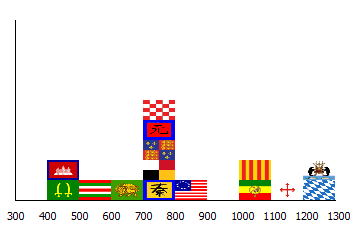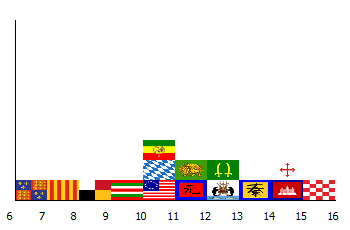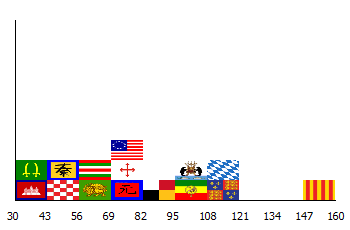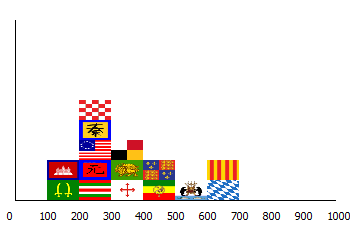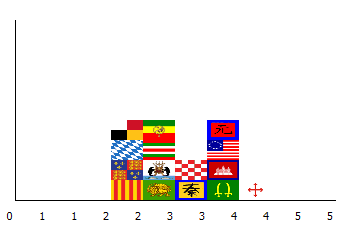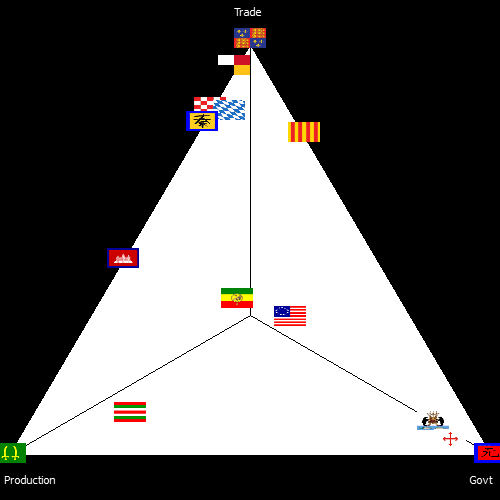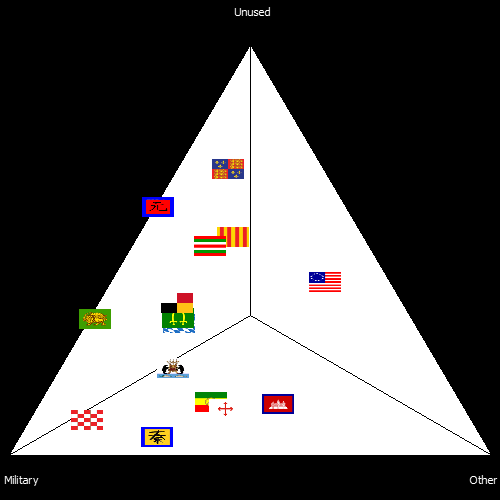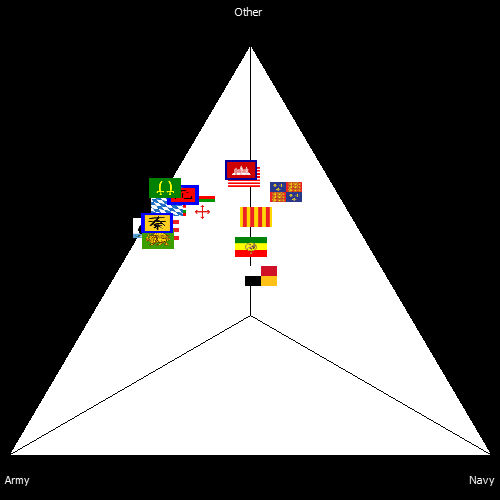Them Dry Numbers
Having finished with Achilles's spirit-quest to become Dictator of Rome and repair the wrongs that were done in his youth, I feel like looking at some dry, unemotional statistics. In particular, how are the players using their magistrates; what fields do they prioritise?
There are two ways of looking at this. One is to consider all buildings, and count how many magistrates have been spent in each field. Another is to consider only the level-5 and level-6 buildings; since there can be only one level-5 building in a province, finding a level-5 is strong evidence of commitment to a given area. Provinces, after all, are perhaps the ultimate limited resource in the game; there will be another magistrate coming along, but gaining provinces is (now that everything is colonised) completely zero-sum.
So, let's start with a table summarising all the information we're looking at. The columns are the number of provinces, total magistrates spent, magistrates spent per province (which is an indicator of economic development; contrast densely-built-up Croatia with the howling wilderness of English North America), total basetax, magistrates per basetax, the percentage of provinces with a level-5 building, and, for each field, (government-army-navy-forts-production-trade) the magistrates-per-province used on that field, and the percentage of provinces with a level-5 building in that field.
Code:
TAG Provs Mags M/P Base M/B Max Govt GovtMax Army ArmyMax Navy NavyMax Fort FortMax Prod ProdMax Trad TradMax
CRO: 50 791 15.82 273 2.90 0.92 0.28 0.00 5.54 0.80 0.70 0.00 1.64 0.00 3.96 0.02 3.00 0.10
ENG: 117 774 6.62 453 1.71 0.32 0.05 0.00 0.59 0.03 1.40 0.18 1.14 0.00 1.99 0.00 1.30 0.11
USA: 80 830 10.38 255 3.25 0.59 1.50 0.19 1.51 0.07 1.29 0.06 1.51 0.00 2.11 0.11 1.95 0.15
BAV: 118 1231 10.43 638 1.93 0.69 0.16 0.01 3.26 0.49 0.27 0.00 1.41 0.00 2.50 0.03 2.53 0.16
CAT: 152 1071 7.05 650 1.65 0.48 0.32 0.05 1.18 0.13 1.30 0.14 1.14 0.00 1.50 0.00 1.41 0.16
NOV: 106 1297 12.24 580 2.24 0.79 1.49 0.20 4.38 0.56 0.18 0.00 1.85 0.00 2.68 0.02 1.25 0.02
TRP: 60 559 9.32 236 2.37 0.50 1.12 0.03 2.43 0.32 0.77 0.02 1.25 0.00 2.80 0.12 0.78 0.02
PER: 59 697 11.81 334 2.09 0.68 1.54 0.00 4.20 0.66 0.47 0.00 1.85 0.00 2.47 0.02 1.00 0.00
ETH: 98 1035 10.56 433 2.39 0.88 0.71 0.10 2.33 0.22 2.38 0.30 1.05 0.00 2.39 0.12 1.52 0.13
KON: 76 1126 14.82 318 3.54 0.89 3.04 0.36 4.01 0.41 1.43 0.09 1.07 0.00 3.13 0.03 1.41 0.01
KHA: 71 783 11.03 238 3.29 0.41 1.25 0.01 2.96 0.39 0.45 0.00 1.61 0.00 2.51 0.00 1.82 0.00
KHM: 34 483 14.21 158 3.06 0.88 0.91 0.00 2.18 0.26 1.74 0.12 1.53 0.00 4.29 0.26 3.15 0.24
QIN: 52 727 13.98 272 2.67 0.96 0.50 0.00 4.77 0.67 0.33 0.00 2.04 0.00 3.02 0.06 2.83 0.23
PUN: 37 455 12.30 150 3.03 0.68 1.08 0.00 3.54 0.49 0.03 0.00 2.05 0.00 3.81 0.19 1.38 0.00
MSA: 91 772 8.48 399 1.93 0.64 0.20 0.00 1.84 0.19 2.16 0.29 1.10 0.00 1.07 0.01 1.71 0.15
It may be worth recalling that when provinces change hands, the buildings disappear unless the conqueror has a core; so nations with land that has changed hands many times will have fewer total magistrates because of it. However, the dominant effect is probably integrated magistrate gain; thus we see Bavaria and Novgorod, with their many vassals, leading the total-magistrates count. But we can also note that never-invaded Ethiopia and Kongo, and Catalunya with its ocean-protected domain in America, are not far behind. Then there's a bit of a jump down to the middle-rank (by this measure, not necessarily overall) powers of about 700-800 magistrates: Croatia, England, USA, Khanate, Qin, Malaya, Persia. Finally there's a rag-tag and bob-tail of minors ranging from 400 to 600: Tripoli, Punjab, Khmer.
There seems to be a sweet spot for maximum province development somewhere around 50 provinces; larger nations can't build up all their provinces (at least not without concentrating exclusively on one area), smaller ones don't have the money (or so I conjecture). Thus we see Qin and Croatia, both around that size, with the highest full-development fractions.
Looking at tables is illuminating but sometimes strains the eyes, so I made some histograms. We can start by showing the total number of magistrates in this form:
Notice that within each bin, the nations in that bin are sorted so the highest flag has the most magistrates. Now we can more clearly see the division into a favoured group with more than a thousand magistrates, a middle rank about 750, and minors with four or five hundred. If we look instead at magistrates per province, however:
we see that Croatia, near the top of the middle ranks by the previous statistic, jumps to first place; Qin makes a similar evolution; and of the former top group, only Kongo retains its high position. Catalunya, formerly ranked fourth, drops to 14th! That said, it is of course a nice question which of these two indices is more important. Density is good, but quantity also has a quality all its own. Indeed, if we look at sheer number of provinces, Catalunya is in a class of its own:
which will, no doubt, spark cries of "Death to perfidious Spain!" Oddman is also king of the hill in terms of total basetax, although the difference is not quite so large:
Finally, in terms of magistrates per basetax, the distribution of nations is rather uniform, with no strong standout, although Kongo is at the top and, perhaps surprisingly, Catalunya at the bottom:
So far I've been considering totals and rankings; now let's have a look at how the nations use what they've got. A small magistrate number is nothing to be ashamed of, it's all in how you prioritise it!
Let us first consider how the nations have used their level-5 buildings; to build such a thing is, in effect, to commit that province to army, navy, government, or economy for the rest of the game. It is of course possible to lose a province and regain it, but I assume nobody builds a high-level building with such a thing in mind. Indeed, my own high-level buildings are well away from the border with Russia, although not everyone has such a luxury. At any rate; as a first cut consider the priorities of army (ie conscription centers), navy (naval bases), and non-military - stock exchange, customs house, cathedral. (Although I've been speaking of level-5 buildings, I list the level-6 ones as the priorities, since it would be pretty silly to build a level-5 and not go for the level-6.)
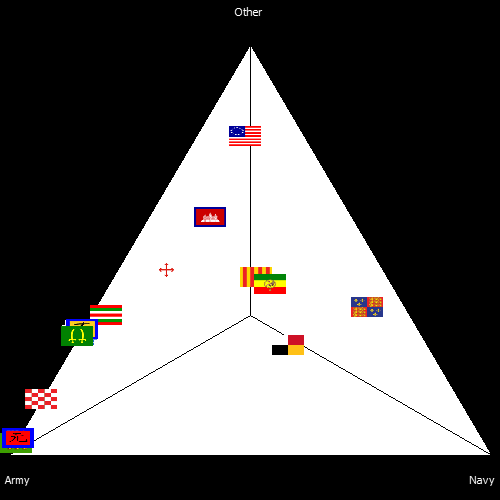
We see from the clustering along the left-hand edge that the continental nations are very heavily army-oriented, while ignoring their navies. They differ only in how much they feel able to divert from army to economy - ranging from the Khanate and Persia, completely focused on their armies, down to Tripoli which splits itself about evenly between army and other. The exceptions are more interesting. We see Malaya and, especially, England, being much more navy-focused (as one might expect); Ethiopia and Catalunya apparently not specialising at all; and the USA focusing very heavily on 'other'. Khmer, too, has apparently given up on competing militarily with its heavyweight neighbours, and is trying to maximise its non-military power.
Now, 'other' is rather an amorphous category, consisting of the sum of government, production, and trade. Let's combine army and navy and split government off from production and trade; then we find this:
Everyone hates the underpowered government buildings, except Novgorod, Kongo, and the US. I theorise that Kongo is trying to increase its literacy for Victoria by building lots of colleges; possibly the US is doing the same. I'm not sure about Novgorod.
Now let's throw out the military entirely and concentrate on the three non-military branches; we know that people hate government, but how do they prioritise between trade and production?
First a note: The Persian, Punjabi, and English focuses are quite misleading here. The Khanate, for example, has exactly one province with high-level buildings that are not military; I needed a college in my capital for some national decision or other. So my apparent complete focus on government is an artifact of having only one building that's not army! Similarly for Punjab and England. Otherwise we see that most people prefer trade, Tripoli is apparently focusing on production, and Ethiopia and the US are either unfocused or balanced - take your choice of adjective.
The Khanate having so few non-army buildings brings up another point; how committed are we to these strategies? Let's see how things divide between military, nonmilitary, and
not committed - which can of course be used later for moving about in the other triangles.
We see Qin and Croatia pretty heavily committed to their respective strategies - they'll need to double in size to change what they're doing. At the other extreme, England has huge amounts of free land that can be used for anything, as does the Khanate - strategic options, yay! We see again that most people lean pretty strongly military. I wonder if anyone will be inspired by the pacific focus of the US to invade? Take the nice rich provinces from the decadently unmilitary people!
Finally, I repeat the three focus triangles using all buildings, instead of just high-level ones:
and find a cluster of army states and a cluster of 'navy' states who are actually not so much navy-focused in the sense that the others are army-focused, as balanced between army and navy. Ruling the waves is, apparently, not sufficient by itself. We also see even more strongly that everyone hates the government buildings, but Kongo hates them the least. In the low-level buildings we're more balanced between trade and production, perhaps due to the widespread perception that the low-level trade buildings are rather underpowered, so people only buy them as stepping stones to the high-level ones.
Word count 1400, and I thought this was going to be a not-much-writing, heavy-on-the-pictures AAR... Anyway, let me know if there's any other statistics you'd like to see in a similar format.

